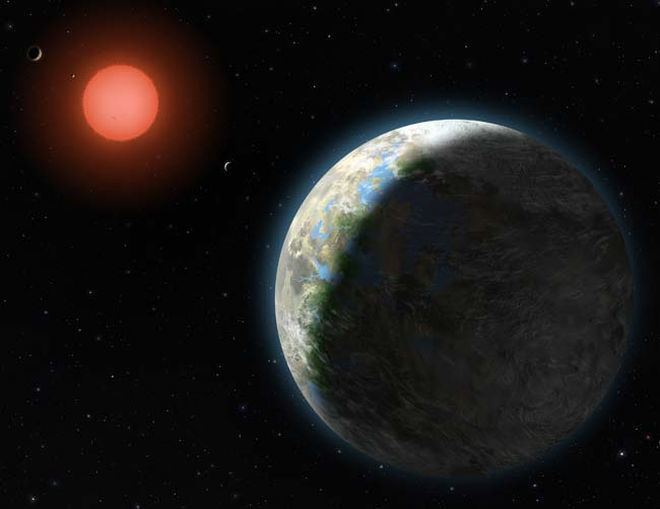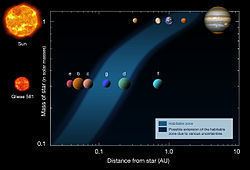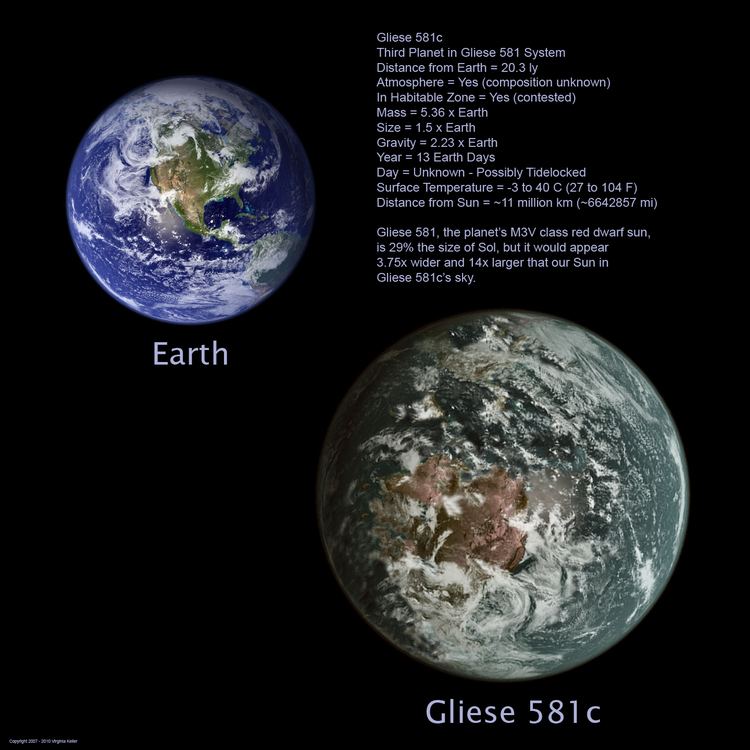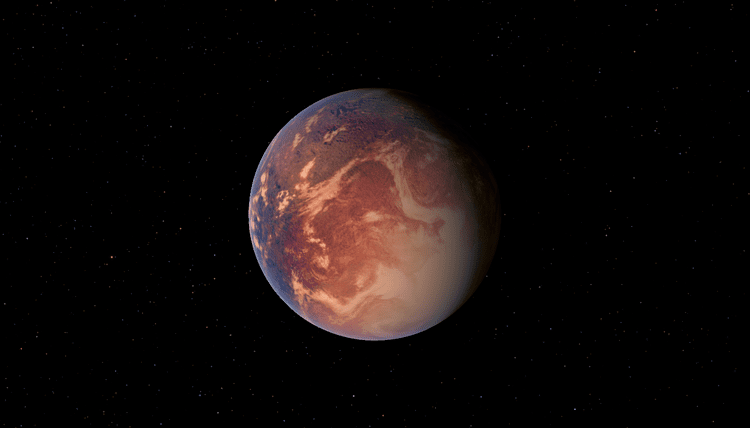Luminosity (bolometric) 0.013 L☉ Distance to Earth 20.22 light years Radius 201,800 km (0.29 R☉) | Luminosity (visual, LV) 0.002 L☉ Surface temperature 3,480 K Spectral type M3V | |
 | ||
Mass 6.166 × 10^29 kg (0.31 M☉) Coordinates RA 15h 19m 27s | Dec -7° 43′ 20″ Similar Gliese 581g, Gliese 581 c, Gliese 581 d, Gliese 667, Gliese 581 e | ||
Earthlike planet gliese 581 gliza a habitable zone
Gliese 581 (/ˈɡliːzə/) is a star of spectral type M3V (a red dwarf) about 20 light years away from Earth in the constellation Libra. Its estimated mass is about a third of that of the Sun, and it is the 89th closest known star to the Sun. Observations suggest that the star has a planetary system consisting of three known planets, designated Gliese 581 b, c, and e and a possibly confirmed planet, d, in order of discovery. Additional outer planets, which received the designations Gliese 581 f, and g have been proposed, but the evidence that led to the discovery claims has been shown to be the result of stellar activity mimicking the radial velocity variations due to orbiting planets.
Contents
- Earthlike planet gliese 581 gliza a habitable zone
- Portrait of gliese 581
- History of observations
- Characteristics
- Planetary system
- Gliese 581 e
- Gliese 581 b
- Gliese 581 c
- Gliese 581 g
- Gliese 581 d
- Debris disk
- History of detections
- Radio signal sent from Earth
- References

Gliese 581 has been the subject of a "huge amount of attention" in the quest to discover the first habitable extrasolar planet; first for c, and then d and g. Gliese 581 c, the first low-mass extrasolar planet found near a habitable zone, was discovered in April 2007. It has since been shown that under known terrestrial planet climate models, Gliese 581 c is likely to have a runaway greenhouse effect, and hence is probably too hot to be habitable, analogous to Venus. The proposed planets Gliese 581 d and Gliese 581 g also received attention as being located within the habitable zone.

On 27 November 2012, the European Space Agency announced a debris disk, with at least ten times as many comets as the Solar System. This put constraints on possible planets beyond 0.75 AU.

Portrait of gliese 581
History of observations

Gliese 581 is known at least from 1886, when it was included in Eduard Schönfeld's Southern Durchmusterung (SD)—the fourth part of the Bonner Durchmusterung. The corresponding designation is BD -7 4003.
Characteristics

The name Gliese 581 refers to the catalog number from the 1957 survey Gliese Catalogue of Nearby Stars of 965 stars located within 20 parsecs of the Earth. Other names of this star include BD-07° 4003 (BD catalogue, first known publication) and HO Librae (variable star designation). It does not have an individual name such as Sirius or Procyon. The star is a red dwarf with spectral type M3V, located 20.4 light-years away from Earth. It is located about two degrees north of Beta Librae, the brightest star in the constellation Libra. Its mass is estimated to be approximately a third that of the Sun, and it is the 89th closest known star system to the Sun.
An M-class dwarf star such as Gliese 581 has a much lower mass than the Sun, causing the core region of the star to fuse hydrogen at a significantly lower rate. From the apparent magnitude and distance, astronomers have estimated an effective temperature of 3200 K and a visual luminosity of 0.2 percent of that of the Sun. However, a red dwarf such as Gliese 581 radiates primarily in the near infrared, with peak emission at a wavelength of roughly 830 nm (estimated using Wien's displacement law, which assumes the star radiates as a black body), so such an estimate will underestimate the star's total luminosity. (For comparison, the peak emission of the Sun is roughly 530 nm, in the middle of the visible part of the spectrum). When radiation over the entire spectrum is taken into account (not just the part that humans are able to see), something known as the bolometric correction, this star has a bolometric luminosity 1.3% of the Sun's total luminosity. A planet would need to be situated much closer to this star in order to receive a comparable amount of energy as the Earth. The region of space around a star where a planet would receive roughly the same energy as the Earth is sometimes termed the "Goldilocks Zone", or, more prosaically, the habitable zone. The extent of such a zone is not fixed and is highly specific for each planetary system.
Gliese 581 is classified as a variable star of the BY Draconis type, and has been given the variable star designation HO Librae. This is a star that exhibits variability because of the presence of star spots combined with the rotation of the star. However, the measured variability is close to the margin of error, and, if real, is most likely a long term variability. Its brightness is stable to 1%. Gliese 581 emits X-rays.
Planetary system
Three confirmed planets and two possible planets are possibly known to orbit Gliese 581, together with a debris disc. Most of the planets are located close to the star and have near-circular orbits. In order of distance from the star, the planets are designated Gliese 581 e, Gliese 581 b and Gliese 581 c and possibly Gliese 581 g and Gliese 581 d. The letters represent the discovery order, with b being the first planet to be discovered around the star (the letter d was used for a planet that was once no longer thought to be real and was an artifact caused by stellar activity, but reanalysis led to the conclusion that d might exist). The planets were all discovered with the radial velocity method which gives only lower limits on the planetary masses and no information about their radii. The minimum mass of the middle planet b is comparable to the solar system ice giants Uranus and Neptune, while the inner and outer planets have minimum masses a few times that of the Earth. The first three planets orbit closer to the star than the inner edge of the habitable zone, with the possibly reconfirmed planets Gliese 581 g and Gliese 581 d orbiting within the habitable zone.
The debris disc has an inclination between 30° and 70°. If the planetary orbits lie in the same plane, their masses would be between 1.1 and 2 times the minimum mass values.
Gliese 581 e
Gliese 581 e is the innermost planet and with a minimum mass of 1.7 Earth masses is the least massive of the three. Discovered in 2009, it is also the most recent confirmed planet to have been discovered in this system. It takes 3.15 days to complete an orbit. Initial analyses suggested that the planet's orbit is quite elliptical but after correcting the radial velocity measurements for stellar activity, the data now indicate a circular orbit.
Gliese 581 b
Gliese 581 b is the most massive planet known to be orbiting Gliese 581 and was the first to be discovered.
Gliese 581 c
Gliese 581 c is the third planet orbiting Gliese 581. It was discovered in April 2007. In their 2007 paper, Udry et al. asserted that if Gliese 581 c has an Earth-type composition, it would have a radius of 1.5R⊕, which would have made it at the time "the most Earth-like of all known exoplanets". A direct measurement of the radius cannot be taken because, viewed from Earth, the planet does not transit its star. The minimum mass of the planet is 5.5 times that of Earth. The planet initially attracted attention as being potentially habitable, though this has since been discounted. The mean blackbody surface temperature has been estimated to lie between −3 °C (for a Venus-like albedo) and 40 °C (for an Earth-like albedo), however, the temperatures could be much higher (about 500 degrees Celsius) due to a runaway greenhouse effect akin to that of Venus. Some astronomers believe the system may have undergone planetary migration and Gliese 581 c may have formed beyond the frost line, with a composition similar to icy bodies like Ganymede. Gliese 581 c completes a full orbit in just under 13 days.
Gliese 581 g
Gliese 581 g, unofficially known as Zarmina (or Zarmina's World), is an unconfirmed (and disputed) exoplanet claimed to orbit the red dwarf star Gliese 581. It was discovered by the Lick–Carnegie Exoplanet Survey, and is the sixth planet orbiting the star; however, its existence could not be confirmed by the European Southern Observatory (ESO)/High Accuracy Radial Velocity Planet Searcher (HARPS) survey team, and its existence remains controversial. It is thought to be near the middle of the habitable zone of its star. That means it could sustain liquid water—a necessity for all known life—on its surface, if there are favorable atmospheric conditions on the planet.
Gliese 581 g was claimed to be detected by astronomers of the Lick–Carnegie Exoplanet Survey. The authors stated that data sets from both High Resolution Echelle Spectrometer (HIRES) and HARPS were needed to sense the planet; however, the ESO/HARPS survey team could not confirm its existence. The planet remained unconfirmed as consensus for its existence could not be reached. Additional reanalysis only found evidence for four planets, but Vogt did not agree with those conclusions; another study by Guillem Anglada‐Escudé later supported the planet's existence. In 2012, a reanalysis by Vogt supported its existence. A new study in 2014 concluded that it was a false positive; however, in 2015, a reanalysis of the data suggested that it could still exist. The planet is thought to be tidally locked to its star. If the planet has a dense atmosphere, it may be able to circulate heat. The actual habitability of the planet depends on the composition of its surface and the atmosphere. It is thought to have temperatures around −37 to −11 °C (−35 to 10 °F). By comparison, Earth has an average surface temperature of 15 °C (59 °F)—while Mars has an average surface temperatures of about −63 °C (−81 °F). The planet has, according to Vogt, a "100%" chance of supporting life, but this is disputed. The supposed detection of Gliese 581 g foreshadows what Vogt calls "a second Age of Discovery".
Gliese 581 d
Gliese 581 d is an exoplanet that was once considered disputed due to inaccurate analysis caused by noise and stellar activity, but reanalysis suggests that it does in fact exist, despite stellar variability. Its mass is thought to be 6.98 Earths and its radius is thought to be 2.2R⊕. It is considered to be a super-Earth, but remarkable in that its orbit is inside the habitable zone and has a solid surface allowing for any water present on its surface to form liquid oceans and even landmasses characteristic of Earth’s surface, although with a much higher surface gravity. Its orbital period is thought to be 66.87 days long, with a semi-major axis of 0.21847 with an unconfirmed eccentricity, Analysis suggests that it orbits within the star's habitable zone, where the temperatures are just right to support life.
Debris disk
On 27 November 2012, the European Space Agency announced that the Herschel space observatory had discovered a comet belt "at 25 ± 12 AU to more than 60 AU". It must have "at least 10 times" as many comets as does the Solar system. This likely rules out Saturn-mass planets beyond 0.75 AU. However another (undiscovered) planet further out, say a Neptune-mass planet at 5 AU, might be required to keep the comet belt replenished.
History of detections
The first announcement of a planet around the star was Gliese 581 b discovered by astronomers at the Observatory of Geneva in Switzerland and Grenoble University in France. Detected in August 2005 and using extensive data from the ESO HARPS spectrometer it was the fifth planet to be discovered around a red dwarf. Further observations by the same group resulted in the detection of two more planets, Gliese 581 c and Gliese 581 d. The orbital period of Gliese 581 d was originally thought to be 83 days but was later revised to a lower value of 67 days. The revised orbital distance would place it at the outer limits of the habitable zone, the distance at which it is believed possible for liquid water to exist on the surface of a planetary body, given favourable atmospheric conditions. Gliese 581 d was estimated to receive about 30% of the intensity of light the Earth receives from the Sun. By comparison, sunlight on Mars has about 40% of the intensity of that on Earth, though if high levels of carbon dioxide are present in the planetary atmosphere, the greenhouse effect could keep temperatures above freezing.
The next discovery was the inner planet Gliese 581 e also by the Observatory of Geneva and using data from the HARPS instrument was announced on 21 April 2009. This planet, at a minimum mass of 1.9 Earths, was at the time the least massive confirmed exoplanet identified around a main-sequence star.
On 29 September 2010, astronomers using the Keck Observatory proposed two additional planets, Gliese 581 f and Gliese 581 g, both in nearly circular orbits based on analysis of a combination of data sets from the HARPS and HIRES instruments. The proposed planet Gliese 581 f was thought to be a 7 Earth-mass planet in a 433-day orbit and too cold to support liquid water. The candidate planet Gliese 581 g attracted more attention: nicknamed Zarmina by one of its discoverers, the predicted mass of Gliese 581 g was between 3 and 4 Earth-masses, with an orbital period of 37 days. The orbital distance was calculated to be well within the star's habitable zone, though the planet was expected to be tidally locked with one side of the planet always facing the star.<ref="Vogt 2010">Vogt, S. S.; et al. (2010). "The Lick-Carnegie Exoplanet Survey: A 3.1 M_Earth Planet in the Habitable Zone of the Nearby M3V Star Gliese 581". arXiv:1009.5733 [astro-ph.EP]. In an interview with Lisa-Joy Zgorski of the National Science Foundation, Steven Vogt was asked what he thought about the chances of life existing on Gliese 581 g. Vogt was optimistic: "I'm not a biologist, nor do I want to play one on TV. Personally, given the ubiquity and propensity of life to flourish wherever it can, I would say that... the chances of life on this planet are 100%. I have almost no doubt about it."
Two weeks after the announcement of the discovery of Gliese 581 f and Gliese 581 g, astronomer Francesco Pepe of the Geneva Observatory reported that in a new analysis of 179 measurements taken by the HARPS spectrograph over 6.5 years, neither planet g nor planet f was detectable, and the relevant measurements were included in a paper uploaded to the arXiv preprint server, though still unpublished in a refereed journal. The non-existence of Gliese 581 f was accepted relatively quickly: it was shown that the radial velocity variations that led to the claimed discovery of Gliese 581 f were instead associated with the stellar activity cycle rather than an orbiting planet. Nevertheless, the existence of planet g remained controversial: Vogt responded in the media that he stood by the discovery and questions arose as to whether the effect was due to the assumption of circular rather than eccentric orbits or the statistical methods used.
Bayesian analysis found no clear evidence for a fifth planetary signal in the combined HIRES/HARPS data set, though other studies led to the conclusion that the data did support the existence of planet g, albeit with strong degeneracies in the parameters as a result of the first eccentric harmonic with the outer planet Gliese 581 d.
Using the assumption that the noise present in the data was correlated (red noise rather than white noise), Roman Baluev called into question not only the existence of planet g, but Gliese 581 d as well, suggesting there were only three planets (Gliese 581 b, c and e) present. A different objection against the existence of Gliese 581 d was offered in a 2014 study whose authors argued that Gliese 581 d is "an artifact of stellar activity which, when incompletely corrected, causes the false detection of the planet g." This remains controversial.
Radio signal sent from Earth
A Message from Earth (AMFE) is a high-powered digital radio signal that was sent on 9 October 2008 toward Gliese 581 c. The signal is a digital time capsule containing 501 messages that were selected through a competition on the social networking site Bebo. The message was sent using the RT-70 radar telescope of Ukraine's National Space Agency. The signal will reach Gliese 581 in early 2029.
